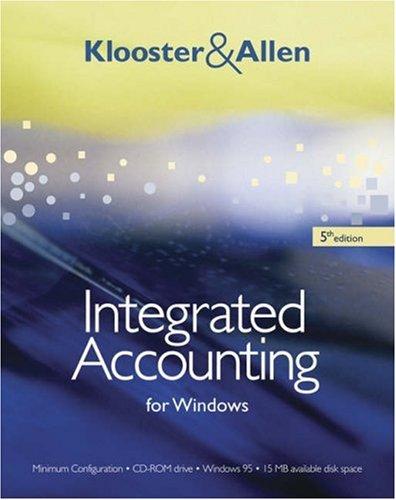Question
1.MC.04.122 Which of the following quantities is an example of an activity driver in activity-based costing? a.number of orders placed b.number of machine hours c.number
1.MC.04.122
Which of the following quantities is an example of an activity driver in activity-based costing?
a.number of orders placed
b.number of machine hours
c.number of setups
d.All of these choices are correct.
2.MC.04.055
The following information is provided by the Salinger Corporation for the year:
Actual direct labor hours worked62,100Budgeted overhead$405,000Budgeted direct labor hours50,500Actual overhead costs incurred$621,000
Which of the following is the predetermined overhead rate, if calculated using direct labor hours? (Round the answer to two decimal places.)
a.$1.53
b.$6.52
c.$8.02
d.$12.30
3.MC.04.195
Which of the following formula is used by Duration-Based Costing (DBC) to assign the overhead costs to a particular product?
a.Overhead cost per unit = Total overhead cost Activity rate
b.Overhead cost per unit = Overhead rate Cycle time for a particular product
c.Overhead cost per unit = Overhead rate Capacity cost rate for a particular product
d.Overhead cost per unit = Units of product produced at practical capacity Activity rate
4.MC.04.099
Which of the following is NOT a limitation of a plantwide overhead rate?
a.Predetermined rates using budgeted overhead are usually the best estimate of the amount of overhead.
b.Product diversity may consume overhead activities under differing consumption ratios.
c.Overhead usage is not strictly linked to the units produced because some products are more complex and diverse than others.
d.Overhead costs tend to be underallocated to highly complex products.
5.MC.04.190
Time-Driven Activity-Based Costing (TDABC) is a before-the-fact simplification method that simplifies the first stage of assigning costs to activities of activity-based costing (ABC) system by:
a.expanding the number of activity rates used so that the rates reflect the actual consumption of overhead costs.
b.eliminating the need for detailed interviewing and surveying to determine resource drivers.
c.recognizing that many of the so-called fixed overhead costs vary in proportion to changes other than production volume.
d.allocating weights and setting the result equal to the product's consumption ratio.
6.MC.04.072
The Brookstone Company produces 9 volt batteries and AAA batteries. The Brookstone Company uses a plantwide rate to apply overhead based on direct labor hours. The following data is given:
Actual Overhead$325,000Estimated Overhead$350,000Estimated Activity:9 volt battery100,000 direct labor hoursAAA battery400,000 direct labor hoursActual Activity:9 volt battery125,000 direct labor hoursAAA battery400,000 direct labor hoursUnits Produced:9 volt battery500,000AAA battery250,000
How much was overhead over/underapplied?
a.$17,500
b.$42,500
c.$25,000
d.None of these choices are correct.
7.MC.04.186
In an approximately relevant ABC system
a.cost pools are limited to only two cost pools.
b.all activities still are separated into pools; they are allocated on estimated activity levels.
c.only the most expensive activities are allocated using appropriate cause-and-effect drivers.
d.None of these choices are correct.
8.MC.04.078
Motorsports, Inc. had a predetermined overhead rate of $2 per direct labor hour. The direct labor hours were estimated to be 25,000. The actual manufacturing overhead incurred was $47,000 and 24,000 actual direct labor hours were worked. How much was overhead over/under applied last year?
a.$1,000 underapplied
b.$1,000 overapplied
c.$3,000 overapplied
d.$2,000 underapplied
9.MC.04.136
Samson Company recently installed an activity-based relational database. Using the information contained in the activity relational table, the following pool rates were computed:
$400 per purchase order
$24 per machine hour, Process 1
$30 per machine hour, Process 2
$80 per engineering hour
Two products are produced by Special Products: L and M. The plant has two manufacturing processes, Process 1 and Process 2. Other processes include engineering, product handling, and procurement. Product L goes through Process 1 while Product M goes through Process 2. The product relational table for Special Products is as follows:
Product L
ActivityDriver #NameActivity Usage1Units200,0002Purchase Orders2503Machine Hours80,0004Engineering Hours1,250
Product M
Activity Driver #NameActivity Usage1Units25,0002Purchase Orders1253Machine Hours10,0004Engineering Hours1,500
How much engineering overhead cost will be assigned to Product M using engineering hours?
a.$120,000
b.$2,000,000
c.$801,000
d.$100,000
10.MC.04.062
The Magnanimous Company uses a predetermined overhead rate of $12 per direct labor hour to apply overhead. During the year, 30,000 direct labor hours were worked. Actual overhead costs for the year were $320,000. The overhead variance is
a.$40,000 underapplied.
b.$35,560 underapplied.
c.$36,000 overapplied.
d.None of these choices are correct.
Step by Step Solution
There are 3 Steps involved in it
Step: 1

Get Instant Access to Expert-Tailored Solutions
See step-by-step solutions with expert insights and AI powered tools for academic success
Step: 2

Step: 3

Ace Your Homework with AI
Get the answers you need in no time with our AI-driven, step-by-step assistance
Get Started


